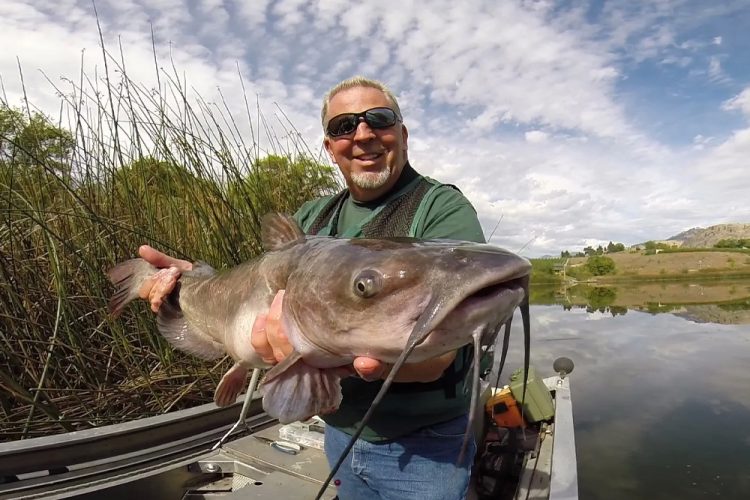WDFW fisheries biologist Marc Petersen holds up an 8-pound channel
catfish caught in Roses Lake in Chelan County. (courtesy of WDFW)
Washington Revives Channel Cat Stocking Program
Source: Washington Dept. of Fish and Wildlife
Catfish are becoming increasingly popular in the Pacific Northwest.
Non-native channel catfish now swim in at least 45 lakes, ponds and reservoirs across Washington State. The first reported introduction in Evergreen State waters was in 1892 when 75 fish went into Clear Lake in Skagit County. That same year 125 channel catfish were stocked into a privately owned farm pond near Vancouver, and 50 were planted at Deer Lake in Spokane County. In 1893, the Boise River in Idaho (a Snake River tributary) received 100 channel cats, and a few were released in the Willamette River in Oregon. Additional releases were made in various lakes and streams across Washington in the ensuing years as well.
The Washington Department of Fish and Wildlife’s (WDFW) channel catfish stocking records go back to intermittent planting in the mid-1990s, and 1999 and 2011. Stocking efforts were revived in 2014 but stopped after one year due to transportation limitations.
Stocking channel catfish came at a high price in 2014. At the time, just a few fish distributors operated around the United States, and the 50,000 channel catfish transported by contracted truck drivers to Washington had to cover some 2,200-plus miles from the Hopper-Stevens Hatchery in Lonoke, Arkansas. Freshwater needed to be resupplied to support fish survival as the truck traveled through five states.
In 2024, after a 10-year hiatus, WDFW found a much closer supplier — Dutchboy Farms Hatchery in Challis, Idaho — and reignited the channel catfish stocking program. These young fish originated from the same Arkansas fish-raising facility, and hatchery trucks could transport them from Idaho to Washington at a lower cost.
Under the approved three-year stocking plan, WDFW planted 12,400 channel catfish averaging 12 inches at a cost of $55,000 this past spring into 12 lakes and ponds in nine counties. WDFW expects to stock another 30,000 fish in 2025 in 19 lakes, costing $100,000. Pending further approval, a 2026 stocking plan includes 50,000 fish into 26 lakes and ponds at a cost of $133,000.
Originally, these nonreproducing channel catfish populations were stocked by WDFW to increase predation on over-abundant forage fish populations and to add diversity to mixed-species fisheries. These efforts have been highly successful in several statewide waterways.
“We’re monitoring the lakes that we’ve planted with channel catfish and have seen anglers with 12- to 13-inch fish,” said Ken Behen, WDFW warmwater fish program manager. “Our hope is to have these lakes and ponds established with a good population of channel catfish. In past surveys, we know that anglers really enjoy catching them.”
WDFW fish biologists select lakes and ponds that are best suited to produce recreational fishing opportunities and high fish survival rates, and where there is no conflict with native fish species like anadromous salmon or steelhead.
Washington’s general statewide regulation for channel catfish is a five-fish daily limit with no minimum size, although several small lakes where channel catfish are stocked have a two-fish daily limit. In the Columbia, Snake and Yakima rivers, there is no daily bag limit on harvest.
For more information, visit www.mywdfw.com.



